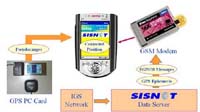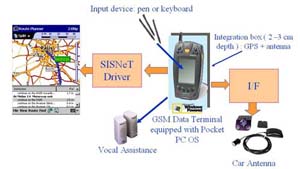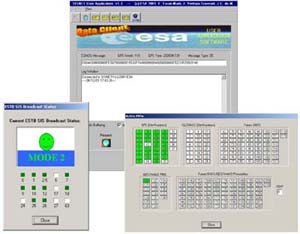 |
 |
|
SISNeT
handheld receiver (based on an iPAQ PDA)
|
|
Signals
used by SISNeT
SISNeT (Signal in Space through the Internet) uses signals from EGNOS, the
European Geostationary Navigation Overlay Service.
EGNOS is the first step in the European contribution to the Global Navigation
Satellite System, and a fundamental stepping-stone towards Galileo, Europe's
own Global Navigation Satellite System. EGNOS is an augmentation system
to the GPS (Global Positioning Satellite) and GLONASS satellite navigation
systems, which provides and guarantees navigation signals for aeronautical,
maritime and land mobile Trans-European network applications.
Since January 2000, a pre-operational signal of EGNOS has been available
through the so-called EGNOS System Test Bed (ESTB). The ESTB is a representative
real-time mock-up of the final EGNOS system.
EGNOS will broadcast their wide-area / integrity message through geostationary
satellites. The ESTB (EGNOS prototype) is already broadcasting the EGNOS
message through the Inmarsat III AOR-E satellite. Broadcast through the
Inmarsat III IOR satellite is also planned in 2002.
Satellite broadcasting through geostationary satellites (GEOs) has proved
to be an efficient strategy for avionic applications and other modes of
transport. For some applications though, GEO broadcasting may have some
limitations because building obstacles in cities or rural canyons can
interfere with the GEO reception.
While the EGNOS messages will still be very useful for transport applications,
a different transmission link may be needed to take full advantage of
the EGNOS potential. For this reason, ESA has recently launched specific
contract activities (through the Advanced System Telecommunication Equipment
programme -ASTE-) to assess and demonstrate architectures where the ESTB
signal is broadcast through non-GEO means (e.g. FM or GSM broadcasting).
In this context, ESA launched an internal project to provide access to
the EGNOS test bed messages through the Internet. This project is called
SISNeT.

SISNeT receiver based on a GSM /
GPRS terminal
SISNeT
availability
In August 2001, the ESA GNSS-1 Project Office set up the first prototype
of the SISNeT concept. This prototype uses a PC computer to implement
the user equipment software. The connection to the Internet was achieved
using a LAN environment (via a proxy server).
Since February 2002, the SISNeT service has been available to the open
Internet through an authentication protocol (see the SISNeT User Interface
Document - version 2.1 and above - for more details).
Developments
ESA has recently
developed three SISNeT-powered applications. These applications anable:
- Real-time
monitoring of the ESTB performance through the Internet
- Real-time
analysis of the ESTB messages
- Real-time
monitoring of the ESTB performance and SIS status through the World
Wide Web. To access this service, click here.
Some of the
current ESA contracts are aimed at developing EGNOS SISNeT-powered receivers
and demonstrating what they can do. These contracts include:
- Development
of an integrated SISNeT receiver, containing a GPS receiver and a GSM
/ GPRS modem (in co-operation with GMV under ESA contract);
- Demonstrations
of SISNeT receivers embedded in cars and buses (in co-operation with
GMV under ESA contract);
- Integration
of the SISNeT technology in professional software tools (in co-operation
with GMV under ESA contract);
- Development
of a handheld SISNeT receiver, based on an iPAQ PDA (Personal Digital
Assistant) (in co-operation with the Finish Geodetic Institute under
ESA contract);
- Development
of a SISNeT receiver based on a GSM (Global System for Mobile communications)
terminal (in co-operation with the Navocap society under ESA contract);

Monitoring
the active satellites and the ESTB broadcast status using the SISNeT User
Application Software
Opportunities
for SISNeT
The SISNET project can deliver significant benefits to the GPS land-user
community. A user equipped with a GPS (Global Positioning Satellite) receiver
and a GSM (or GPRS) modem can access the SISNET services and benefit from
the EGNOS augmentation signals, even under situations of GEO blocking.
The combination of the power of EGNOS and the almost unlimited capabilities
of the Internet offers the opportunity for the development of a multitude
of applications for satellite navigation.
To stay in touch with the progress of SISNeT technology, please do not
forget to periodically visit the ESA SISNeT website.
Last update: 8 July
2002
|

